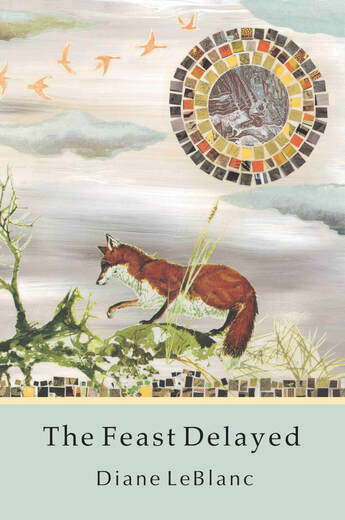 Reviewed by Amy Beth Sisson
Reviewed by Amy Beth Sisson
The Feast Delayed
by Diane LeBlanc
Terrapin Books
75 pages, $16.00, May 2021, ISBN-13: 978-1947896413
Diane Leblanc’s first full-length book of poems, The Feast Delayed, explores what happens when grief makes a home in the body. In LeBlanc’s poetry, grief enters through the senses, often the sense of taste. The collection is imbued with flavors. While I read, they lingered on my tongue. In some of the poems, the flavors are bitter and reflect the bitterness of loss and injustice. The prose poem “Expired” takes us through the journey of cleaning out the spice cupboard, of searching out the jars past their expiration dates. The speaker of the poem tastes each one until they taste confusion. The poem suggests we regret the flavors we fail to taste when we leave a jar on a shelf. It is about more than the loss of people the speaker loves. It also addresses loss in our political and cultural life:
I once made winter cookie rings with cardamom. Eating them was like swallowing the bisque of dawn when anything is possible, before I remember who has died, who has been elected, who we are now without parents and the poets we never imagined dying.
The poem suggests we resist delay. But the moment of tasting is not an unalloyed joy. Even the delicious can be marred. The poem “In January,” about consuming a pear, urges us to take care of what we put into our body—“I eat around/the dark spots.” Scholar Lucy Alford describes the stuff of poetry as attention: “What, then, is formed, tensed, in poetic form? Attention.” The poems in The Feast Delayed brings us to a world of subtle attention where we should leave no spice off our tongue while eating around the dark spots.
What happens when our ability to attend is changed by illness? Recently I have seen poetry commended for being embodied but not all bodies are equal in sensation. LeBlanc explores this in the poem “Craving.” After learning that the vision “…of an orange sphere burns against a dark sky.” is caused by glaucoma, the speaker doubts what is before her eyes. “I even doubt the postage stamp casting water’s blue shadow/on a snowy egret’s neck. I doubt but can’t stop looking.” The poem ends with a craving for belief. The ill or aging body pays a new kind of attention.
In “Striations” the speaker dips bread (an act of communion or a ritual of attention?) into oil. She explores the “kit” needed to survive widowhood. Obscure knowledge that spans from mushrooms to comet dust. She alludes to the sexual loss of widowhood when she invokes Ishtar, the goddess of sex (and war), “I recall a song for Ishtar full of rocking and grunting. Lusty widow warrior planet.” The final line speaks to me of the accumulations of memory and myth, “I try to imagine trading my lover between worlds. So many striations in these stories. More than I can know.” Later in the collection, in the poem “April Night,” the image of layers returns, “swallows layer a new nest/ on the old, their stack of bowls.” Read together, the poems work as an accumulation of layers with many repeated images: tracks, comet dust, nutmeg to name just a few. The repetition is another form of attention.
The collection pays attention to music both as theme and in language. In “Between Fact and Footnote,” “Fiddle strings separating north and south/will answer a bow but not tonight’s cold wind.” Listen to how the “F” sounds like the f-holes in a violin, and the staccato “T” sounds intensify meaning in the lines, “Note: Tufts of fur in a wire fence say which creature/tore in, tore through, got away.”
LeBlanc is also a book artist. Her attention to craft and the process of making art is reflected in her poetry. In the poem “Orientation” the speaker sees how a maze designer is always looking at space and creating a puzzle in his mind, Her husband studies the curve and break of every mile. An evening walk is like rolling an olive up a waterfall. No one wants to be lost forever. Just long enough. “Shadow Theory” shows the painterly eye “It’s wrong to mix brown with an object’s color to paint the/shadow it casts. Better to darken the surface color.”
The book opens with a prefatory poem “After the Storm.” Its position in the collection suggests that it might give the reader a clue for how to read the work, as in the line, “I follow deer tracks into the woods.” The speaker seems to urge us to follow the tracks, but the path is still not clear, “Hooves press deep, clean holes. Good for planting, if only.” If only what? I sit with LeBlanc’s images of the near and astral, of the quotidian and unreachable. The collection reminds us to live in the space of the connections and contradictions of nature and to trace both the footprints in snow and the comet dust. To pay deep attention, taste, and remember.
About the reviewer: Amy Beth Sisson is struggling to emerge, toad-like, from the mud outside of Philly. Her poetry has appeared in Cleaver Magazine, The Night Heron Barks, and Ran Off With the Star Bassoon and is upcoming in The River Heron Review and The Shoutflower. She thinks about the aging body, the history of life in her small town, and how to fight despair. Starting in the 2020 lockdown, she began making a series of stress doodles of flowers using cheap markers. She is currently an MFA student studying poetry at Rutgers Camden. Find Amy on Twitter: #sissonab, IG: amy_beth_sisson and http://www.amybethsisson.com